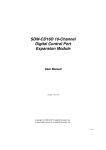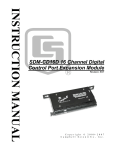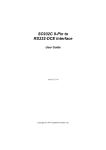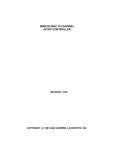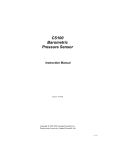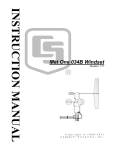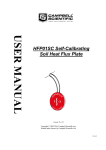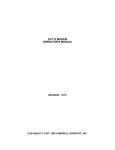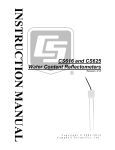Download Campbell SDM-CD16D User guide
Transcript
SDM-CD16D 16 Channel Digital Control Port Expansion Module User Guide Issued 15.6.99 Copyright 1999 Campbell Scientific Ltd. Guarantee This equipment is guaranteed against defects in materials, workmanship, and software. This guarantee applies for twelve months from date of delivery. We will repair or replace products which prove to be defective during the guarantee period provided they are returned to us prepaid. The guarantee will not apply to: • Equipment which has been modified or altered in any way without the written permission of Campbell Scientific • Batteries • Any product which has been subjected to misuse, neglect, acts of God or damage in transit. Campbell Scientific will return guaranteed equipment by surface carrier prepaid. Campbell Scientific will not reimburse the claimant for costs incurred in removing and/or reinstalling equipment. This guarantee and the Company’s obligation thereunder is in lieu of all other guarantees, expressed or implied, including those of suitability and fitness for a particular purpose. Campbell Scientific is not liable for consequential damage. Please inform us before returning equipment and obtain a Repair Reference Number whether the repair is under guarantee or not. Please state the faults as clearly as possible, and if the product is out of the guarantee period it should be accompanied by a purchase order. Quotations for repairs can be given on request. When returning equipment, the Repair Reference Number must be clearly marked on the outside of the package. Note that goods sent air freight are subject to Customs clearance fees which Campbell Scientific will charge to customers. In many cases, these charges are greater than the cost of the repair. Campbell Scientific Ltd, Campbell Park, 80 Hathern Road, Shepshed, Leicestershire, LE12 9RP, UK Tel: +44 (0) 1509 601141 Fax: +44 (0) 1509 601091 Email: [email protected] www.campbellsci.co.uk Contents 1. Introduction ...................................................................1 2. Control Specifications ..................................................1 2.1 General ................................................................................................ 1 2.2 Output Specifications ........................................................................... 2 3. Power Considerations ..................................................2 4. Installation .....................................................................3 4.1 Controlled Device Connections ............................................................ 4 5. Address Selection Switches ........................................5 6. Datalogger Instructions 104 (CR10/10X, CR23X, 21X & newer CR7s) and 29 (older CR7s) ...................6 7. Theory of Operation ......................................................7 8. Program Example..........................................................7 Figures 1. 2. 3. 4. 5. SDM-CD16D ......................................................................................... 1 Equivalent Output Driver Circuit ........................................................... 2 Connection Block Diagrams................................................................... 3 Use of Terminal Blocks.......................................................................... 5 Address Selection Switch ....................................................................... 6 Tables 1. Datalogger to SDM-CD16D Connections............................................... 4 2. Switch Position and Address .................................................................. 5 SDM-CD16D 16 Channel Digital Control Port Expansion Module The SDM-CD16D (see Figure 1) is a synchronously addressed peripheral. It has 16 control ports and is compatible with Campbell Scientific’s CR10/10X, CR23X, CR7 and 21X dataloggers. Figure 1 SDM-CD16D 1. Introduction The SDM-CD16D expands the digital output capability of Campbell Scientific dataloggers. The outputs can be set to 0 or 5V by the datalogger. In addition to being able to drive normal logic level inputs, when an output is set HI a ‘boost’ circuit allows it to source a current of up to 100mA, allowing direct control of low voltage valves, relays etc. The SDM-CD16D is a synchronously addressed datalogger peripheral. Datalogger control ports 1, 2 and 3 are used to address the SDM-CD16D then clock out the desired state of each of the 16 control ports. Up to sixteen SDM-CD16Ds may be addressed, making it possible to control a maximum of 256 ports from the first three datalogger control ports. NOTE CR10/10X, CR23X, CR7 and 21X dataloggers use I/O Instruction 104 to control the SDM-CD16D. Older dataloggers with pre-OS7.1 software may not have the necessary instruction, or may use Instruction 29. Ensure that your datalogger contains the appropriate instruction before using. 2. Control Specifications 2.1 General Compatible dataloggers: CR10/10X, CR23X, CR7 and 21X Operating voltage: 12V DC nominal (9 to 18V) Current drain at 12V DC: 100µA typical (All ports HI, no load) Total cable length: 6m (CR10/10X, CR23X, 21X), 180m (CR7) 1 SDM-CD16D 16 Channel Digital Control Port Expansion Module 2.2 Output Specifications NOTE Output Voltage (no load): Output ON/HI, Nominal 5V (Minimum 4.5V) Output OFF/LO, Nominal 0V (Maximum 0.1V) Output Sink Current: Output will sink 8.6mA from a 5V source* Output Source Current: Output will source 36mA @ 3V, 115mA short-circuited to ground* Max. Output Current: (total all outputs) 400mA at 50°C and 12V supply (see NOTE below) The maximum current should be derated under the following conditions: 50mA for every 10°C above 50°C and/or 50mA for every volt above 12V. Operating temp.: -25°C to +70°C standard Size: 230mm wide x 100mm high x 24mm deep Weight: 350g EMC Status: Complies with EN55022-1:1998 and EN50082-1:1998 * If more detailed output characteristics are required, experienced users should consult the equivalent circuit diagrams shown in Figure 2, below. 0.6V Drop Output 580R 510R 39R Output 5V, 0Ω V Output set ON/HI Output set OFF/LO Figure 2 Equivalent Output Driver Circuit 3. Power Considerations The SDM-CD16D power requirements are large compared to most Campbell Scientific products when driving significant loads. For many applications an external power supply, as shown in Figure 3, is recommended to power the SDM-CD16D. For some applications it may be convenient to use the datalogger supply to power the SDM-CD16D, as shown in Figure 3. For long-term applications, the lead-acid power supply available with Campbell Scientific dataloggers should be used, allowing the batteries to be float charged. Alkaline batteries are not recommended for long term applications. 2 User Guide EXTERNAL 9 TO 18V DC + – GND SDM-CD16D 12V C1 DATALOGGER C2 C3 Connection with External Supply GND SDM-CD16D 12V C1 C2 C3 DATALOGGER Connection with Datalogger Supply Figure 3 Connection Block Diagrams NOTE If the 21X power supply is used to power the SDM-CD16D, all low level analogue measurements (thermocouples, pyranometers, thermopiles, etc.) must be made differentially. This is a result of slight ground potentials created along the 21X analogue terminal strip when the 12V supply is used to power peripherals. This limitation reduces the number of available analogue input channels and may make an external supply for the SDM-CD16D essential. 4. Installation For correct operation the SDM-CD16D must be installed where there is no risk of water ingress or condensation. CAUTION The order in which connections are made is critical. Always connect 12V first, followed by ground, then the control ports. For datalogger connections, see Table 1, below. Please refer to Figure 4 for details of how to use the spring-loaded terminals. 3 SDM-CD16D 16 Channel Digital Control Port Expansion Module Table 1 Datalogger to SDM-CD16D Connections Connection Order SDM-CD16D Datalogger First 12V 12V on datalogger or external supply or G Second C1 C2 C3 C1 (Control Port 1) C2 (Control Port 2) C3 (Control Port 3) Function Power Common Ground Data Clock Enable Multiple SDM-CD16Ds may be wired in parallel by connecting the datalogger side of one SDM-CD16D to the next. The transient protection of the SDM-CD16D relies on a low resistance path to earth. Ensure that the ground return wire has as low a resistance as possible. Where long cable runs are likely, or where lightning damage is a possibility, the SDM-CD16D can be fitted with gas discharge tubes. Please contact Campbell Scientific for details. NOTE For CR10/10X, CR23X and 21X dataloggers, the total cable length connecting SDM-CD16Ds to SDM-CD16Ds and the datalogger should not exceed 6m. Total cable lengths in excess of 6m will adversely affect communication performance. For CR7 dataloggers, the total cable length can be up to 180m. 4.1 Controlled Device Connections The SDM-CD16D uses spring-loaded terminal blocks, which provide quick, vibration resistant, connections. The output terminals are labelled 1 to 16. A common ground connector is provided between each pair of terminals Use a screwdriver in either the top or front slot, as appropriate, to open the terminal spring. Strip any insulation from the wire to give 7 to 9mm bare wire. Push the wire into the opening, and, while holding it in position, withdraw the screwdriver to release the spring. The wire will now be firmly held in place. See Figure 4, below. NOTE 4 You cannot reliably insert more than one solid-core wire into one terminal connector unless the wires are soldered or clamped together. When inserting more than one stranded wire, twist the bare ends together before insertion. User Guide Use a screwdriver in appropriate slot to release spring tension Strip insulation and insert wire Figure 4 Use of Terminal Blocks 5. Address Selection Switches Each SDM-CD16D can have 1 of 16 addresses.The factory-set address is 00. Table 2 shows switch position and the corresponding address. Figures 1 and 5 shows the position of the switch. Note that you will have to remove the mounting bracket to gain access to this switch. Table 2 Switch Position and Addresses Switch Setting Base 4 Address 0 1 2 3 4 5 6 7 8 9 A B C D E F 00 01 02 03 10 11 12 13 20 21 22 23 30 31 32 33 5 SDM-CD16D 16 Channel Digital Control Port Expansion Module Use a screwdriver to select address Figure 5 Address Selection Switch 6. Datalogger Instructions 104 (CR10/10X, CR23X, 21X, CR7) and 29 (older CR7s) Instruction 104 is used by the CR10/10X, CR23X, CR7 and 21X to control the SDM-CD16D, and Instruction 29 is used by older CR7s.The Instruction descriptions are shown below. Instruction 104 – SDM-CD16D used with CR10/10X, CR23X, CR7 and 21X dataloggers Parameter 1 2 3 Type 2 2 4 Description Reps (No. of modules sequentially addressed) Starting Address (base 4: 00..33) Starting Input Location Execution Time = 2ms per Rep for the CR10/10X and CR23X 3.5ms per Rep for the 21X and CR7 Instruction 29 – SDM-CD16D used with older CR7s Parameter Type Description 1 2 3 4 5 2 2 2 2 4 Reps (No. of modules sequentially addressed) Device (2 = SDM-CD16D) Starting Address (base 4: 00..33) Card (Excitation card No.) Starting Input Location Execution Time = 150ms to 190ms per Rep The number of SDM-CD16Ds to be addressed is defined by the Reps (repetitions) parameter. Each Rep sequentially addresses (00, 01, 02,...32, 33) SDM-CD16Ds, starting with the address specified in parameter 2 (parameter 3 for Instruction 29). For each repetition, the 16 ports of the addressed SDM-CD16D are set according to 16 sequential input locations starting at the input location specified in parameter 3 (parameter 5 for Instruction 29). Any non-zero value stored in an input location activates (sets HI 5V) the associated SDM-CD16D port. A value of zero (0) de-activates the port (sets LO 0V). For example, assuming two repetitions and a starting input location of 33, outputs 1 to 16 of the first SDM-CD16D are set according to input locations 33 to 48, and outputs 1 to 16 of the second SDM-CD16D are set according to input locations 49 to 64. 6 User Guide For older CR7s with Instruction 29, the Device (parameter 2) specifies what type of synchronously addressed peripheral is to be addressed. The Device code for an SDM-CD16D is 2. For Instruction 29 only (older CR7s), the Card parameter (parameter 4) specifies which 725 Excitation Card is being used for the control port signals. The Reps parameter does not advance beyond the specified Card, requiring another Instruction 29 for each 725 Excitation Card used. 7. Theory of Operation On power-up, all SDM-CD16D outputs are off /LO. The SDM-CD16D is a synchronously addressed peripheral. C2 and C3, driven high by the datalogger, initiate a cycle. While holding C3 high, the datalogger drives C2 as a clock line and C1 as a serial data line. The datalogger shifts out a data bit on C1 (LSB first) on the falling edge of the C2 clock. The SDM-CD16D shifts in the C1 data bit on the rising edge of the C2 clock. The first eight bits clocked out represent the SDM-CD16D address. If the address matches the SDM-CD16D’s address, the SDM-CD16D is enabled. If enabled, the next 16 bits are shifted into the SDM-CD16D, each bit controlling one port, the first of which controls output 1. When the 16 control bits are clocked in, C2 is held high while C3 is pulsed low then high to latch the control bits. The datalogger then lowers both C3 and C2 to complete the cycle. 8. Program Example The example is written for the CR10/10X Measurement and Control Module. The program concepts presented are the same for the CR23X, 21X and CR7 dataloggers with minor changes in the program code. In this example, the SDM-CD16D is used to control the temperature between 23°C and 28°C in each of five greenhouses. In each greenhouse the SDM-CD16D controls a heating unit, a refrigerating unit and an air mixing fan according to the following conditions: Heating unit: Activate when temperature <23.5°C. Deactivate when temperature >25.5°C. Cooling unit: Activate when temperature >27.5°C. Deactivate when temperature <24.5°C. Mixing fan: Activate whenever the heating or cooling units are activated. Activate for 5 minutes out of every 15 minutes. The program assumes that the temperature measurements have been made, and that the average temperature for each greenhouse is computed and stored in input locations 1 to 5. For further information on loops and input location indexing, please refer to your datalogger manual. Input location assignments are as follows: Input Location 1..5 Input Location Label Temp #1..#5 Description Avg. temp. greenhouse 1..5 7 SDM-CD16D 16 Channel Digital Control Port Expansion Module 10..14 Heat #1..#5 Heater control, greenhouse 1..5 SDM-CD16D Port 1..5 15..19 Cool #1..#5 Cooler control, greenhouse 1..5 SDM-CD16D Port 6..10 20..24 Fan #1..#5 Fan control, greenhouse 1..5 SDM-CD16D Port 11..15 ;{CR10X} ; *Table 1 Program 01: 5 Execution Interval (seconds) Master loop: end loop at step 30 1: Beginning of Loop (P87) 1: 0 Delay 2: 5 Loop Count Start heater control logic 2: 1: 2: 3: 4: If (X<=>F) (P89) 1 -- X Loc [ Temp_1 4 < 23.5 F 30 Then Do 3: 1: 2: 3: Z=F (P30) 1 F 0 Exponent of 10 10 -- Z Loc [ Heat_1 4: End (P95) 5: 1: 2: 3: 4: If (X<=>F) (P89) 10 -- X Loc [ Heat_1 2 <> 0 F 30 Then Do 6: 1: 2: 3: 4: If (X<=>F) (P89) 1 -- X Loc [ Temp_1 3 >= 25.5 F 30 Then Do 7: 1: 2: 3: Z=F (P30) 0 F 0 Exponent of 10 10 -- Z Loc [ Heat_1 8: End (P95) 9: Else (P94) 10: Z=F (P30) 1: 0 F 2: 0 Exponent of 10 3: 10 -- Z Loc [ Heat_1 11: 8 End (P95) ] if temperature is below heater threshold then put a ‘1’ into heater control location ] end ‘then do’ ] if the heater is on (heater control location <>0) then ] check upper threshold to see if heater should be turned off if heater should be turned off, enter a ‘0’ into heater control location ] end ‘then do’ else, if the heater is off enter a ‘0’ into heater control location ] end ‘then do/else’ User Guide End heater control logic Start cooler control logic 12: 1: 2: 3: 4: If (X<=>F) (P89) 1 -- X Loc [ Temp_1 3 >= 27.5 F 30 Then Do 13: Z=F (P30) 1: 1 F 2: 0 Exponent of 10 3: 15 -- Z Loc [ Cool_1 14: If (X<=>F) (P89) 15 -- X Loc [ Cool_1 2 <> 0 F 30 Then Do 16: 1: 2: 3: 4: If (X<=>F) (P89) 1 -- X Loc [ Temp_1 4 < 24.5 F 30 Then Do 17: Z=F (P30) 1: 0 F 2: 0 Exponent of 1 3: 15 -- Z Loc [ Cool_1 18: End (P95) 19: Else (P94) 20: Z=F (P30) 1: 0 F 2: 0 Exponent of 10 3: 15 -- Z Loc [ Cool_1 if ‘cooler on’ threshold is exceeded then put a ‘1’ into cooler control location ] end ‘then do’ End (P95) 15: 1: 2: 3: 4: 21: ] ] if cooler is on (cooler control location <>0) then ] check lower threshold to see if cooler should be turned off if cooler should be turned off put a ‘0’ into cooler control location ] end ‘then do’ else, if cooler is off put a ‘0’ into cooler control location ] end ‘then do/else’ End (P95) End cooler control logic Start fan control logic based on heater/cooler 22: 1: 2: 3: 4: If (X<=>F) (P89) 10 -- X Loc [ Heat_1 2 <> 0 F 11 Set Flag 1 High 23: 1: 2: 3: 4: If (X<=>F) (P89) 15 -- X Loc [ Cool_1 2 <> 0 F 11 Set Flag 1 High if heater is on ] set flag 1 if cooler is on ] 24: If Flag/Port (P91) 1: 11 Do if Flag 1 is High 2: 30 Then Do 25: Z=F (P30) 1: 1 F set flag 1 if flag 1 is set then put a ‘1’ into fan control location 9 SDM-CD16D 16 Channel Digital Control Port Expansion Module 2: 0 3: 20 26: Exponent of 10 -- Z Loc [ Fan_1 else, if flag 1 is reset Else (P94) 27: Z=F (P30) 1: 0 F 2: 0 Exponent of 10 3: 20 -- Z Loc [ Fan_1 28: ] put a ‘0’ into fan control location ] end ‘then do/else’ End (P95) reset flag 1 29: Do (P86) 1: 21 Set Flag 1 Low 30: end master loop End (P95) End fan control logic based on heater/cooler Start fan control logic based on time if 5 minutes remain out of 15 minute interval set flag 2 31: If time is (P92) 1: 10 Minutes (Seconds --) into a 2: 15 Interval (same units as above) 3: 12 Set Flag 2 High 32: If Flag/Port (P91) 1: 12 Do if Flag 2 is High 2: 30 Then Do if flag 2 is set 33: Beginning of Loop (P87) 1: 0 Delay 2: 5 Loop Count start fan loop 34: Z=F (P30) 1: 1 F 2: 0 Exponent of 10 3: 20 -- Z Loc [ Fan_1 then put a ‘1’ into fan control location ] 35: End (P95) end fan loop 36: End (P95) end’ then do’ 37: If time is (P92) reset flag 2 at the 1: 0 Minutes (Seconds --) into a end of the 15 minutes 2: 15 Interval (same units as above) 3: 22 Set Flag 2 Low End fan control logic based on time Input locations 10 to 24 are now loaded with a ‘1’ or ‘0’ to set ports on the SDM-CD16D 38: SDM-CD16 / SDM-CD16D (P104) 1: 1 Reps 2: 00 Address 3: 10 Loc [ Heat_1 ] send instructions to the SDM-CD16D with address 00 *Table 2 Program 02: 0.0000 Execution Interval (seconds) *Table 3 Subroutines End Program -Input Locations1 Temp_1 7 4 0 2 Temp_2 10 0 0 3 Temp_3 10 0 0 10 User Guide 4 Temp_4 10 0 0 5 Temp_5 18 0 0 6 _________ 0 0 0 7 _________ 0 0 0 8 _________ 0 0 0 9 _________ 0 0 0 10 Heat_1 7 3 3 11 Heat_2 11 1 0 12 Heat_3 11 1 0 13 Heat_4 11 1 0 14 Heat_5 19 1 0 15 Cool_1 7 3 3 16 Cool_2 11 1 0 17 Cool_3 11 1 0 18 Cool_4 11 1 0 19 Cool_5 19 1 0 20 Fan_1 7 1 3 21 Fan_2 11 1 0 22 Fan_3 11 1 0 23 Fan_4 11 1 0 24 Fan_5 19 1 0 25 _________ 1 1 0 26 _________ 0 0 0 27 _________ 0 0 0 28 _________ 0 0 0 29 _________ 0 0 0 11

















